|
 In
1988, the Petroleum History Society issued a limited-edition set of pins
commemorating historical events in the first 100 years of Canada's oil
and gas industry. In
1988, the Petroleum History Society issued a limited-edition set of pins
commemorating historical events in the first 100 years of Canada's oil
and gas industry.
The pins were created and sold to help fund the society's
first Oral History Project, which taped the memories of petroleum industry
pioneers for future generations.
1858 - Oil Springs, Ontario
1908 - Bow Island, Alberta
1914 - Dingman Well, Alberta
1920s - Oil Sands, Alberta
1920 - Norman Wells, Northwest Territories
1947 - Leduc, Alberta
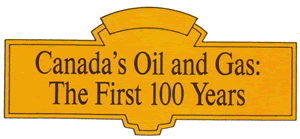
1858 - Oil Springs, Ontario
|
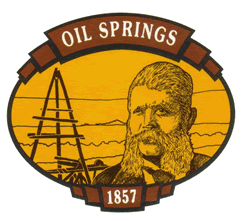 |
|
James Miller Williams dug the first oil well in North America at
Oil Springs, Ontario, in 1858, fully one year before the more famous
Drake well in Pennsylvania. Although intended as a water well, when
the Williams No. 1 well found free oil twenty metres below surface,
it set off a flurry of activity which briefly made southwestern
Ontario a world leader in petroleum drilling and production skills
and technology.
|
1908 - Bow Island, Alberta
|
 |
Spudded in 1908, Old Glory was the name of the discovery well which
located the Bow Island gas field, the first major discovery in Alberta's
earliest important commercial oil and gas exploration venture. Developing
the field led to the first pipelines delivering natural gas to Alberta
communities. Construction of a 16-inch pipeline from southwest of
Medicine Hat to Calgary began on April 22, 1912 and was completed
in only 86 days. A second leg reached Lethbridge on July 12, 1912.
The Bow Island pin depicts the celebration in Calgary on July 17,
1912, when 12,000 Calgarians gathered to watch Mrs. Eugene Coste
- wife of the man who drilled Old Glory and founded Canadian Western
Natural Gas - light the inaugural flare with a roman candle.
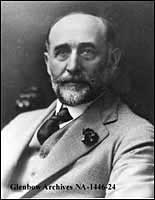 |
Eugene
Coste
(Glenbow Archives
NA-1446-24) |
|
1914 - Dingman Well, Alberta
|
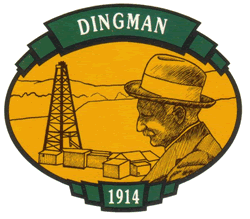 |
|
May 14, 1914, was a victorious day for Arthur W. Dingman as he
and his associates savoured the fruits of their risk-taking. This
puny success, the Dingman wet gas discovery, was the precursor for
the deeper zone find. Drilled ten years later just a few kilometres
away, Royalite No. 4 put Turner Valley on the oil and gas map.
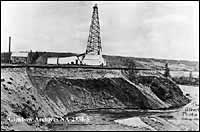 |
Dingman
Well #2, 1914
(Glenbow Archives NA-2335-5) |
|
| The Turner
Valley Gas Plant is a Provincial and National Historic Site which
is being preserved and reclaimed. This link will take you
to more information on the Alberta
Government's website in the Museums and Historic Sites
section. |
1920 - Norman Wells, Northwest Territories
|
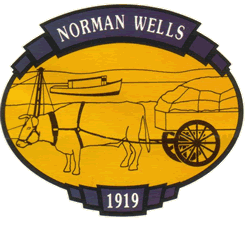 |
Led by geologist Ted Link, in 1919 a crew of six drillers and an
ox named "Nig" made a six-week 1900 kilometre journey
northward by railway, river boat and on foot to the site now known
as Norman Wells along the Mackenzie River. The ox helped to build
a log house and put the drilling rig in place before being butchered
to provide food for the drillers during the long cold winter. Drilling
resumed in the spring with the world's most northerly oil discovery
coming in on August 23, 1920.
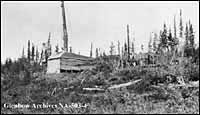 |
First
Imperial Oil well, Norman Wells, 1920
(Glenbow Archives NA-503-4) |
|
1920s - Oil Sands, Alberta
|
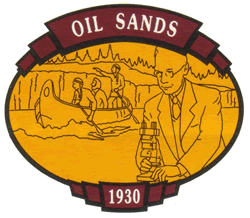 |
|
The world's largest known petroleum deposit, Alberta's oilsands
were used as a caulking material and for other purposes by Indians,
probably for thousands of years. But the first white explorer to
note them was Peter Pond, who wrote in his diary in 1778 of "springs
of bitumen which flow along the ground" near the intersection
of the Clearwater and Athabasca rivers. During the 1920s, the Alberta
Research Council's Dr. Karl Clark developed the hot water process
used today to produce synthetic oil from strip mined bitumen at
two plants near Fort McMurray.
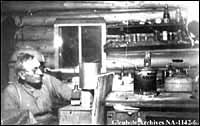 |
| (Glenbow
Archives NA-1142-6) |
|
1947 - Leduc, Alberta
|
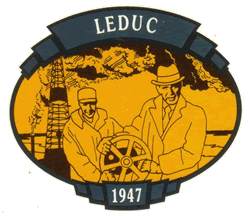 |
Imperial Oil's February 13, 1947 landmark crude oil discovery at
Leduc, 40 kilometres southwest of Edmonton, represented the beginnings
of the modern oil industry in Canada. Based on a classic photo,
this pin shows industry (personified by Vernon Taylor, Imperial's
production manager) and the Alberta Government (personified by the
Honourable N. E. Tanner, Minister of Lands and Mines). Their hands
on the valve wheel symbolize the vital and enduring linkage between
enlightened regulators and energetic industry.
|
|

